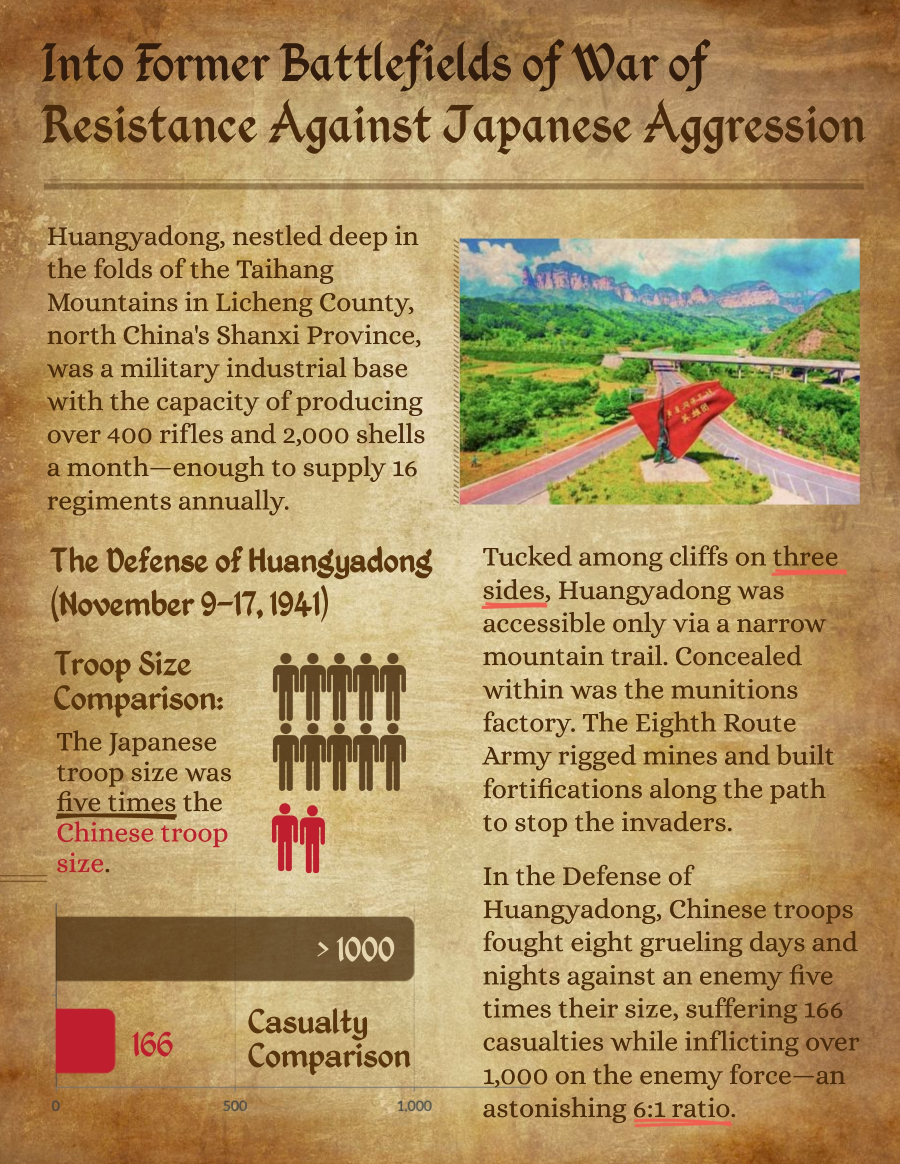


When it comes to wartime gear, the standard cliche is that our army survived on “millet and rifles.” During the War of Resistance Against Japanese Aggression, we were severely under-equipped.
In his 1937 “Guerrilla Song,” He Luting wrote: “(We have) No guns, no shells—only what the enemy gives us…” Yet secretly, there was a place producing over 400 rifles and 2,000 shells a month—enough to supply 16 regiments annually.
That hidden powerhouse was Huangyadong—nestled deep in the folds of the Taihang Mountains, in Licheng County of Shanxi province. Commander Zhu De praised it as “the jewel in the palm of the Eighth Route Army.”
Such a strategic point naturally became a thorn in the Japanese aggressors’ side. In October 1940, the Japanese Ōgaki Detachment launched a brutal assault. To defend this “jewel”, Deputy Commander Peng Dehuai personally led the historic Battle of Guanjia’nao. Later, the Special Service Regiment and Deputy Chief of Staff Zuo Quan of the Eighth Route Army were mandated to fortify the position.
Despite repeated defeats, the Japanese persisted. In November 1941, over 5,000 troops from the 36th Division and the 4th Mixed Brigade, under air and artillery cover, again advanced on Huangyadong.
Special Service Regiment commander Ou Zhifu was tasked with holding the position to protect the factory’s relocation.
Zuo Quan ordered the troops to exploit the rugged terrain, dig in, hold out for reinforcements, then counterattack. His orders were rigid—hold firm for five days.
Tucked among cliffs on three sides, Huangyadong was accessible only via a narrow mountain trail. Concealed within was the munitions factory. The Eighth Route Army rigged mines and built fortifications along the path to stop the invaders.
Japanese fighter jets circled above the valley repeatedly but were not able to identify a target. Their heavy shells managed to dislodge rocks, which in turn blocked their own advance. After several failed assaults and over 200 casualties, they still pressed on, flinging themselves at the cliffs.
And then, countless acts of heroism unfolded:
Seventeen-year-old bugler Cui Zhenfang held a narrow ravine alone. Flanked by near-vertical cliffs, he lobbed grenades ceaselessly, repelled over 10 attacks, killed dozens of enemies—and paid with his life in the end. For seven relentless days the Japanese didn’t advance an inch.
Enraged, the enemy deployed flamethrowers and incendiary bombs. Twelve brave souls, including Wang Zhenxi, caught fire—yet in final defiance they threw grenades and leaped from their fortifications to take the enemy with them. Three men, including Wen Desheng, lured a group toward the cliff and, out of ammo, jumped to their deaths to shield the command post…
When five days passed, Zuo Quan asked Ou Zhifu if they could hold longer and give the Japanese a surprise attack once reinforcements arrived. Ou’s reply was unwavering: “No problem—we’ll stand our ground.”
At last, reinforcements arrived. Led by Ou Zhifu, the Special Service Regiment struck swiftly. Cornered from both sides, the Japanese forces collapsed.
In the Defense of Huangyadong, our troops fought eight grueling days and nights against an enemy five times their size, suffering 166 casualties while inflicting over 1,000 on the enemy force—an astonishing 6:1 ratio.
The Eighth Route Army honored the Special Service Regiment as the “Heroic Unit in the Defense of Huangyadong.” Chairman Mao Zedong himself wrote: “The whole Army must study this battle!”
Over 80 years have passed, and the battlefield at Huangyadong has long faded into memory.
As Qingming arrives, snow falls across the Taihang Mountains, cloaking the rigged landscape in white. Tender new shoots push through the snow, bringing color and hope to an otherwise frozen land.
Zhao Naitang polishes the tombstones in the dawn’s glow, their surfaces gleaming gold. For 34 years, he has tended the graves of 44 martyrs, waking before dawn each day to keep the memorial pristine amid scarlet cliffs and ancient woods.
His father once carried supplies for the Eighth Route Army’s munitions factory on mountain trails. In spring 1991, Zhao learned the cemetery needed a caretaker. He packed his bedding, took up the mantle—and never left, honoring his father’s legacy in spirit.
“Huangyadong’s cliffs stand below; Peach Blossom Village bears no blooms. The heroes’ spirits endure forever, and war’s drums call forth victory…” Yang Shangjun, a folk historian from the Licheng County Party History Office, sang in his local dialect. As a passionate storyteller, he comes to the old battlefield often to share these historical tales—and there are always more to tell.
Following Yang Shangjun, I visited a rural household at the mountain’s foot. During the war, the Eighth Route Army’s Ordnance Department was once stationed there. Jia Zhilan’s sister, nicknamed “Fat Jia,” became the wet nurse for a staff member’s child. When Japanese troops swept in, to protect the child, she leapt off a cliff and died—yet the baby survived and was later named “Jinsheng” (“reborn in Shanxi”)
Years rolled by. In 2006, Zhai Huanzhang, once a guard for the Ordnance Department and a former lodger, wrote to Jia Zhilan the following words:
“I lived at your home for nearly two years… Your village has changed so much. The paved roads, the new houses—it’s remarkable. As long as everyone follows the Party in building the country, life will only improve!”
And indeed, better days have come. Today, Huangyadong thrives with red-themed tours, ecotourism, and folk-heritage travel, and the locals are living much better lives.
A gentle mountain breeze rustles pine branches. In the days of tough battles, trees were chopped down to craft rifle stocks, grenade handles, and ammo boxes—but after years of ecological restoration, the Huangyadong tourism area now boasts 93% forest coverage, with over 300 rare plant species, and more than 50 species of wild animals.
Strolling through Huangyadong’s spring hills, I was thrown into a chorus performed by pines, I saw blooming wildflowers, and breathed in the sweet aroma of fresh grass.
As I was immersed in such soothing environment, a bus marked “Educational Tour” pulled up. A group of college-aged students got off, filming this historical journey on their phones: “Look—this is the view, and right behind us is the old battlefield!” “The old revolutionary area is beautiful.” “I want to try all these programs: shooting, outdoor exercises, and water sports!”
Said local tour guide named Guo Shasha: “Last year, 600,000 visitors to Huangyadong brought in more than 50 million yuan. Our red-heritage training programs reached more than 20 provinces. This isn’t just a former battlefield—it’s an enduring landmark of a revolutionary spirit!”
As dusk falls and the gentle breeze stirs, the martyrs’ monument stands surrounded by wreaths, their scent floating in the twilight. Guo Shasha’s voice resonates in the evening hush: “Huangyadong will never forget—each stone and tree here remembers those who gave their lives to protect it!”
As dusk settles, lights begin to twinkle at the foot of the mountain. Expanded homestays nestled in the valley glow like stars. Smoke from farmhouse kitchens mingles with the scent of millet porridge. Along the Huangyadong route, Upper and Lower Chiyu villages now host over 30 guesthouses and homestays with more than 400 high-standard rooms—serving over 1,000 guests while providing 500 local jobs for villagers.
Wang Fangping, the granddaughter-in-law of Jia Zhilan, now runs her own homestay business. Her menu brims with nostalgic home dishes: bean jelly, mixed stew, dried persimmons, handmade noodles—comfort food from the old days. Wang’s mountain-bold voice rings out: “Tourists have come for this exact taste. When asked why, they say—they want to experience the flavor of the past!”
点击右上角![]() 微信好友
微信好友
 朋友圈
朋友圈

请使用浏览器分享功能进行分享
